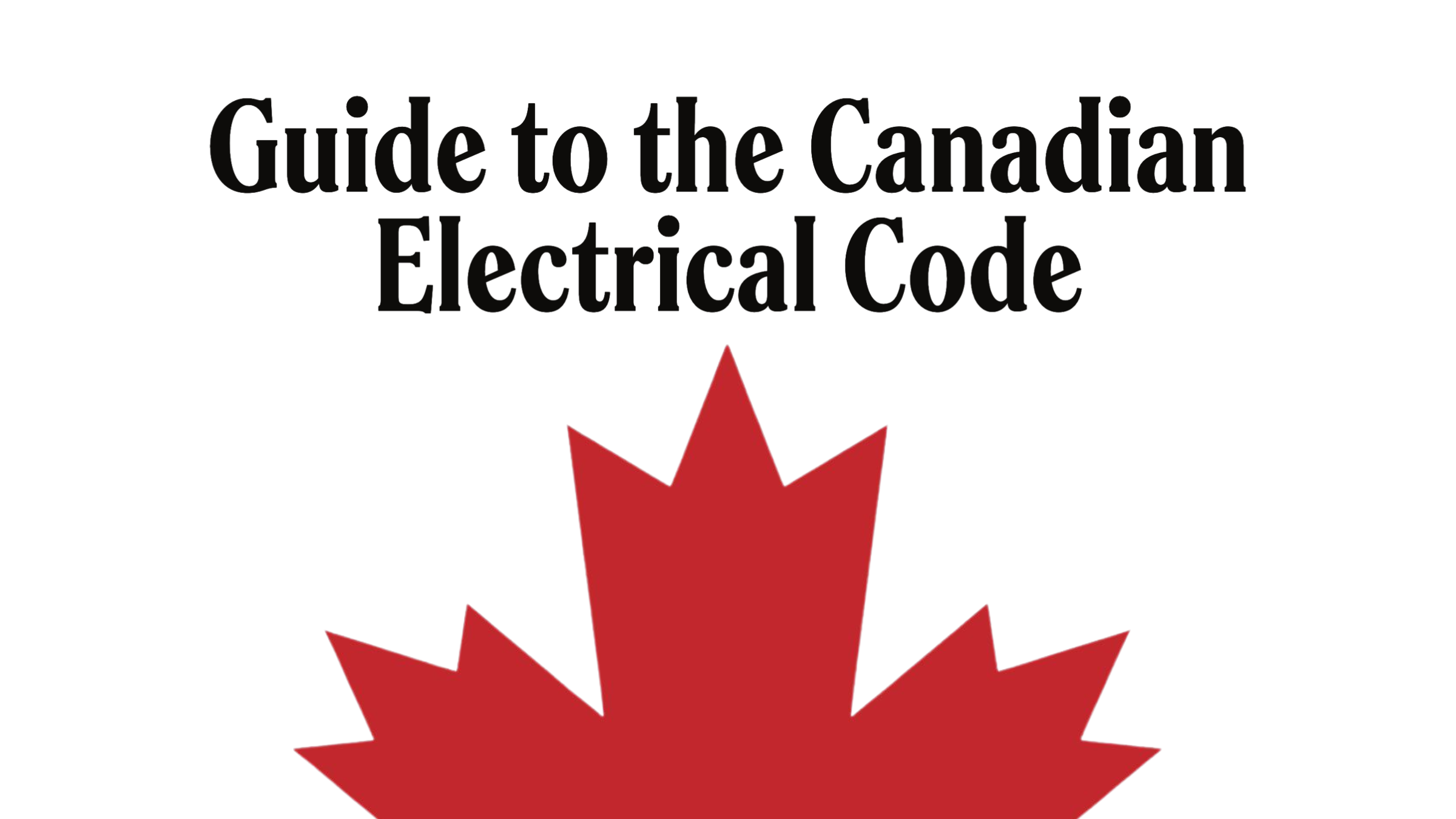Guide to the Canadian Electrical Code, Part 1[i], 26th Edition – A Road Map: Section 26

January 10, 2025
by William (Bill) Burr[i]
[i] William (Bill) Burr is an associate member of the Canadian Electrical Code, Part 1, Technical Committee and formerly Chair of the Canadian Advisory Council on Electrical Safety (CACES), Chief Electrical and Elevator Inspector for the Province of BC & the Northwest Territories, Director of Electrical and Gas Standards Development and Director of Conformity Assessment at CSA Group. Bill can be reached at Burr and Associates Consulting billburr@gmail.com..
Section 26 – Installation of electrical equipment – Part A

The Code is a comprehensive document. Sometimes it can seem quite daunting to quickly find the information you need. This series of articles provides a guide to help users find their way through this critical document. This is not intended to replace the notes in Appendix B, or the explanations of individual requirements contained in the CEC Handbook but will hopefully provide some help in navigating the Code.
Section 26 is a general section of the code and applies to the installation of all electrical equipment. Appendix B contains important additional helpful notes. This section is divided into several parts, with the general rules 26-002 to 26-012 applying to all electrical equipment and additional parts for specific types of equipment. Specific equipment may need to meet requirements in more than one part, so be sure to read all parts that may apply to your situation. In addition, other supplementary or amendatory sections of the code may apply to the installation of specific equipment so always check those parts.
General
Rule 26-002 requires that, in all cases where a device has an identified terminal or lead, it must be connected to the circuit identified conductor.
Rule 26-004 requires that where any electrical equipment, installed directly over a combustible surface, is open at the bottom or marked to require protection, a 1.6 mm thick steel plate extending 150 mm beyond the edge must be installed to cover the combustible surface. Note that equipment certified after Sept 30, 1986 only requires this protection if so marked.
Rule 26-006 states that ventilation of enclosures must not be restricted.
Rule 26-008 specifies that all outdoor installations must be housed in suitable enclosures or surrounded by fencing as per 26-300 to 26-324 and must be bonded to ground.
Rules 26-010 and 26-012 provide the requirements for the installation of dielectric liquid-filled equipment indoors and outdoors. Guidance is given in preventing fire and environmental hazards from leaking or venting liquid. The appendices B and G notes provide additional guidance.
Isolating switches – see Section 0 – Definitions
Rule 26-100 outlines that Isolating switches must be plainly marked to minimize the chance that they will be opened under load, unless
- they are located or guarded so that they are inaccessible to unauthorized persons; or
- they are interlocked so that they cannot normally be opened under load.
Circuit breakers – see Section 0 – Definitions
Rule 26-120 concerns indoor installed circuit breakers and requires dielectric liquid-filled circuit breakers to conform to Rule 26-010, and circuit breakers installed in electrical equipment vaults to be operable without opening the vault.
Fuses and fusible equipment
Rules 26-140 and 26-142 outline where fuses must be located and the selection of type of fuses for all fusible equipment using Rules 14-200, 14-212(b), Table 1 or 3 and Column 4 of Table 2 or 4 as a guide.
Capacitors
Rules 26-200 to 26-222 provide the requirements for the installation of all capacitors. The rules cover indoor installation of dielectric liquid-filled capacitors (as per Rule 26-010) and the guarding, grounding, conductor sizes and overcurrent protection of capacitors. These rules also cover the provision, location and rating of disconnecting means for capacitor feeders and branch circuits; the rating of contactors; motor circuit capacitors; transformers supplying capacitors and drainage of stored charge capacitors. Note that this part does not cover capacitors that are components of factory assembled electrical equipment or surge protectors, which are certified as assembled equipment. The CEC Handbook has additional guidance on the installation and protection of capacitors.
Transformers
This part contains the requirements for the installation of all transformers and unit substations.
Rules 26-240 to 26-266 specify general requirements, outdoor installations, unit substations, transformers mounted on roofs, dielectric liquid-filled transformers indoors, and dry-core, open-ventilated transformers.
Rules 26-248 to 26-254 apply to disconnecting means and overcurrent protection for all transformers.
Rule 26-256 outlines determining the conductor size for transformers in conjunction with the ampacity and the rules of Section 14.
Rule 26-258 provides for coordination between the connected loads and the ampacity of the transformer overcurrent and conductor ampacities in accordance with Rule 8-104(5) or (6).
The final four rules in this part provide specifications for overcurrent protection of instrument voltage transformers Rule 26-260, marking of transformers Rule 26-262, auto-transformers Rule 26-264 and zero sequence filters Rule 26-266.
Fences
Rules 26-300 to 26-324 outline the requirements for constructing fences to guard electrical equipment installed outdoors. The rules cover clearance between the fence and live electrical equipment, height of fences, use of barbed wire, setting of posts, gates, chain link fabric, the use of wood, material and size of posts, top rails, wood stringers, wood slats and preservative treatment. Table 33 is also referenced in this part.
Electrical equipment vaults – see Section 0 – Definitions
Rules 26-350 to 26-356 provide the general, size, construction and illumination required for electrical equipment vaults. Appendix B and G have additional information regarding electrical equipment vaults.
Cellulose nitrate film storage
Rules 26-360 to 26-368 apply to any areas where cellulose nitrate film is stored (note that generally filmmakers are no longer using cellulose nitrate film, however, there may be storage of archival material). These rules specify that no electrical equipment, other than fixed lighting, may be installed in the film vault. These rules also specify wiring methods, luminaires, and circuits in the film vault.
Lightning Arrestors
Rules 26-400 to 26-404 outline the requirements for use, location, and installation of lightning arrestors both indoors and outdoors. Rules 26-406 to 26-410 describe the requirements for installation of choke coils, connection and insulation of accessories of lightning arrestors.
Low-voltage surge protective devices
Rule 26-420 governs the installation and connection of low voltage surge protective devices. Note that Appendix B has additional guidance on the use of these devices.
Rules 26-500 to 26-548 are Reserved for future use.
Resistance Devices
Rules 26-550 to 26-554 provide requirements for the installation, location, selection of conductors, and the use of incandescent lamps as resistance devices.
Panelboards – see Section 0 – Definitions
Rules 26-600 and 26-602 prescribe the requirements for panelboards in dwelling units and the location of panelboards.
Branch circuits
Rule 26-650 providesSpecial terminology for these rules including arc-fault protection, combination-type arc-fault circuit interrupter and outlet branch-circuit-type arc-fault circuit interrupter. The distinction between the two types of arc-fault circuit interrupters (AFCI) is important in observing these rules.
Rule 26-652 requires that branch circuits located below ground level in areas designated as flood hazard zones must be with ground fault protection with a setting sufficient to allow normal operation of connected loads under normal conditions. (see Appendix B).
Branch Circuits in Residential Occupancies
Rules 26-654 to 26-656 apply to branch circuits for all residential occupancies which includes dwelling units and single dwellings and provides requirements for the type, and location of branch circuits in indicated locations.
Receptacles
Rules 26-700 to 26-712 apply generally to all receptacles.
Rule 26-700 requires the
- configuration of all receptacles be in accordance with Diagrams 1 and 2 with a few exceptions and to be connected to circuits having corresponding voltage and ampere ratings.
- the prevention of interchangeability of receptacles connected to differently rated or configured circuits on the same premises.
- installation requirements for receptacles with exposed terminals, located in floors, and installed facing downwards.
- Receptacles after installation to have their faces project a minimum of 0.4 mm from conductive faceplates, no openings that permit a 6.75mm rod to enter, and not prevent the use of an approved attachment plug.
- Receptacles having CSA configuration 5-15R or 5-20R installed within 1.5 m of sinks must not be located on the area of the counter directly in front of the sink; and on the area of the wall directly behind the sink, except where the distance between the wall and the inside edge of the sink is not less than 450 mm.
Rule 26-702 requires thatwhere grounding-type receptacles are used in existing installations to replace the ungrounded type, the grounding terminal must be effectively bonded to ground by
- connection to a metal raceway or cable sheath that is bonded to ground
- connection to the system ground by means of a separate bonding conductor; or
- bonding to an adjacent grounded metal cold-water pipe and
- at existing outlets where a bonding means does not exist in the outlet box, grounding-type receptacles may be installed, but must be provided with a ground fault circuit interrupter of the Class A type and not be extended to any other outlet.
Rule 26-704 requires that receptacles having CSA configuration 5-15R or 5-20R be protected by a Class A type ground fault circuit interrupter where installed
- within 1.5 m of sinks (wash basins complete with a drainpipe), bathtubs, shower stalls or
- installed outdoors and within 2.5 m of finished grade except where the receptacle is intended for a stationary appliance designated for the location; and is located behind the stationary appliance and inaccessible for use with general purpose portable appliances.
Rule 26-706 specifies that all receptacles of CSA configuration 5-15R and 5-20R installed in
- childcare facilities;
- guest rooms and suites of hotels and motels.
- preschools and elementary education facilities; or
- dwelling units the following locations
must be tamper-resistant receptacles and be so marked except for receptacles dedicated for stationary appliances where the receptacle is inaccessible or located above 2 m from the floor or finished grade.
Rules 26-708 to 26-712 provide requirements for the installation of receptacles exposed to the weather, for receptacles located on rooftops for the maintenance of equipment and receptacle for sump pumps. Appendix B provides some additional guidance on these subrules.
Receptacles for Residential Occupancies.
Rules 26-720 to 26-724 apply to receptacles installed in residential occupancies which includes dwelling units and single dwellings. See Section 0 – Definitions for the distinction between these terms.
Rule 26-720 applies generally to receptacles installed in all residential occupancies and provides requirements for the type, location, and control, of receptacles in indicated locations.
Rule 26-722 applies to receptacles installed in dwelling units, which includes single dwellings. The rule provides requirements for the type, number, location, and control of receptacles in indicated locations.
Rule 26-724 applies to receptacles installed outdoors and in garages for single dwellings and specifies that
- at least two duplex receptacles, readily accessible from ground or grade level shall be installed on two opposite sides of the single dwelling; or on adjacent sides of the dwelling and separated from each other by one half of the width of the longest side. Except where the dwelling has a grade level perimeter of 20 m or less only one receptacle is required.
- at least one duplex receptacle readily accessible from floor or grade level be provided for each car space in a garage or carport of a single dwelling.; and
- one receptacle be provided in a garage for each cord-connected overhead garage door opener located within 1 m of the overhead door opener.
Electric Heating and Cooking Appliances
Rules 26-740 to 26-750 apply to heating and cooking appliances and provides requirements for the location, installation, supply connection, type of receptacle, branch circuit, heat signaling and control for electric heating and cooking appliances.
Heating Equipment
Rules 26-802 to 26-808 apply to circuits supplying power to non-portable fuel fired heating equipment. These requirements provide for mechanical protection of conductors, safety controls, type and rating of branch circuits, location and disconnecting means for heating equipment.
Pipe Organs
Rule 26-900 applies to the installation of electrically operated pipe organs and requires a console pilot light and a receptacle for a portable lamp.
Submersible Pumps
Rules 26-950 to 26-956 apply to the installation of submersible pumps.
Rule 26-950 outlines that the special terminology for these rules includes a deep well submersible pump intended to be used in a well casing and a submersible pump intended to be submerged in open water.
Rule 26-952 applies to all submersible pumps and requires them to be installed in accordance with the manufacturer’s instructions as well as this section.
Rule 26-954 applies to deep well submersible pumps installed in wells and provides requirements for the type, support, installation and marking of power supply conductors, and bonding to ground of the pump.
Rule 26-956 applies to submersible pumps installed in bodies of water and provides the requirements for the voltage supply, bonding to ground, wiring method, and ground fault protection.
Data Processing
Rule 26-1000 requires the isolation of branch circuits supplying data processing units.
Previous Installment: Section 24 — Health care areas.
In the next instalment we will be discussing Section 28 – Motors and generators
[i] Source: CSA C22.1:24, Canadian Electrical Code, Part 1 – Safety Standard for Electrical Installations. © 2021 Canadian Standards Association. Please visit Store – CSA Group or call 1-800-463-6727. With the permission of CSA Group, the material is reproduced from CSA Group standard CSA C22.1:21, Canadian Electrical Code, Part 1 – Safety Standard for Electrical Installations. This material is not the complete and official position of CSA Group on the referenced subject, which is represented solely by the Standard in its entirety. While use of the material has been authorized, CSA Group is not responsible for the manner in which the data are presented, nor for any representations and interpretations. No further reproduction is permitted. For more information or to purchase standard(s) from CSA Group, please visit Store – CSA Group or call 1-800-463-6727.

















